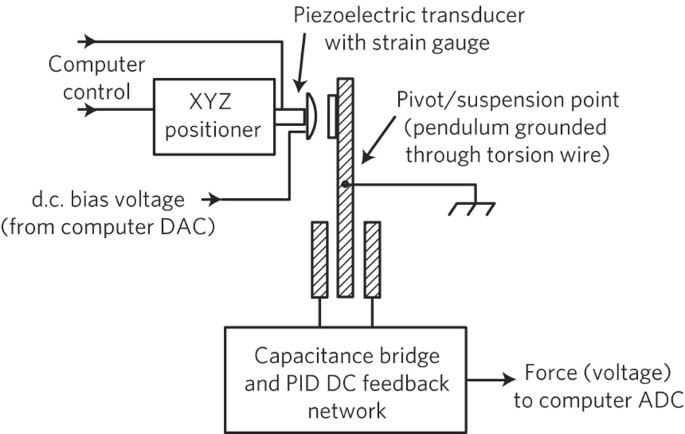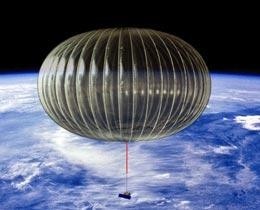
- Select a language for the TTS:
- UK English Female
- UK English Male
- US English Female
- US English Male
- Australian Female
- Australian Male
- Language selected: (auto detect) - EN
Play all audios:
ABSTRACT Quantum theory predicts the existence of the Casimir force between macroscopic bodies, a force arising from the zero-point energy of electromagnetic field modes around them. A
thermal Casimir force, due to thermal rather than quantum fluctuations of the electromagnetic field at finite temperature, was theoretically predicted long ago. Here we report the
experimental observation of the thermal Casimir force between two gold plates. We measured the attractive force between a flat and a spherical plate for separations between 0.7 μm and 7 μm.
An electrostatic force caused by potential patches on the plates’ surfaces is included in the analysis. Previous measurements of the quantum-fluctuation-induced force have been unable to
clearly settle the question of whether the correct low-frequency form of the dielectric constant dispersion for calculating Casimir forces is the Drude model or the plasma model. Our
experimental results are in excellent agreement (reduced _χ_2 of 1.04) with the Casimir force calculated using the Drude model, including the _T_=300 K thermal force, which dominates over
the quantum fluctuation-induced force at separations greater than 3 μm. The plasma model result is excluded in the measured separation range. Access through your institution Buy or subscribe
This is a preview of subscription content, access via your institution ACCESS OPTIONS Access through your institution Subscribe to this journal Receive 12 print issues and online access
$259.00 per year only $21.58 per issue Learn more Buy this article * Purchase on SpringerLink * Instant access to full article PDF Buy now Prices may be subject to local taxes which are
calculated during checkout ADDITIONAL ACCESS OPTIONS: * Log in * Learn about institutional subscriptions * Read our FAQs * Contact customer support SIMILAR CONTENT BEING VIEWED BY OTHERS
RADIATIVE LOSS OF COHERENCE IN FREE ELECTRONS: A LONG-RANGE QUANTUM PHENOMENON Article Open access 26 January 2024 FINGERPRINTS OF NONEQUILIBRIUM STATIONARY DISTRIBUTIONS IN DISPERSION
RELATIONS Article Open access 08 June 2021 SCHRÖDINGER–POISSON SYSTEMS UNDER GRADIENT FIELDS Article Open access 20 September 2022 REFERENCES * Casimir, H. B. G. On the attraction between
two perfectly conducting plates. _Proc. K. Ned. Akad. Wet._ 51, 793–795 (1948). MATH Google Scholar * Sparnaay, M. Measurements of attractive forces between flat plates. _Physica_ 24,
751–764 (1958). Article ADS Google Scholar * Lamoreaux, S. K. Demonstration of the Casimir force in the 0.6 to 6 μm range. _Phys. Rev. Lett._ 78, 5–8 (1997). Article ADS Google Scholar
* Lamoreaux, S. K. Casimir forces: Still surprising after 60 years. _Phys. Today_ 60, 40–45 (February, 2007). Article Google Scholar * Milonni, P. _The Quantum Vacuum : An Introduction
to Quantum Electrodynamics_ (Academic, 1994). Book Google Scholar * Bressi, G., Carugno, G., Onofrio, R. & Ruoso, G. Measurement of the Casimir force between parallel metallic
surfaces. _Phys. Rev. Lett._ 88, 041804 (2002). Article ADS Google Scholar * Derjaguin, B. V. Untersuchungen über die Reibung und adhäsion, IV. _Kolloid-Z._ 69, 155–164 (1934). Article
Google Scholar * Blocki, J., Randrup, J., Swiatecki, W. J. & Tsang, C. F. Proximity forces. _Ann. Phys._ 105, 427–462 (1977). Article ADS Google Scholar * Lifshitz, E. M. The theory
of molecular attractive forces between solids. _Sov. Phys. JETP_ 2, 73–83 (1956). Google Scholar * Sabisky, E. S. & Anderson, C. H. Verification of the Lifshitz theory of the van der
Waals potential using liquid-helium films. _Phys. Rev. A_ 7, 790–806 (1973). Article ADS Google Scholar * Mohideen, U. & Roy, A. Precision measurement of the Casimir force from 0.1 to
0.9 μm. _Phys. Rev. Lett._ 81, 4549–4552 (1998). Article ADS Google Scholar * Chan, H. B., Aksyuk, V. A., Kleiman, R. N., Bishop, D. J. & Capasso, F. Quantum mechanical actuation of
microelectromechanical systems by the Casimir force. _Science_ 291, 1941–1944 (2001). Article ADS Google Scholar * Decca, R. S., López, D., Fischbach, E. & Krause, D. E. Measurement
of the Casimir force between dissimilar metals. _Phys. Rev. Lett._ 91, 050402 (2003). Article ADS Google Scholar * Kim, W. J., Sushkov, A. O., Dalvit, D. A. R. & Lamoreaux, S. K.
Measurement of the short-range attractive force between Ge plates using a torsion balance. _Phys. Rev. Lett._ 103, 060401 (2009). Article ADS Google Scholar * Feiler, A. A., Bergstrom, L.
& Rutland, M. W. Superlubricity using repulsive van der Waals forces. _Langmuir_ 24, 2274–2276 (2008). Article Google Scholar * Munday, J. N., Capasso, F. & Parsegian, V. A.
Measured long-range repulsive Casimir–Lifshitz forces. _Nature_ 457, 170–173 (2009). Article ADS Google Scholar * Obrecht, J. M. et al. Measurement of the temperature dependence of the
Casimir–Polder force. _Phys. Rev. Lett._ 98, 063201 (2007). Article ADS Google Scholar * Bostrom, M. & Sernelius, B. E.. Thermal effects on the Casimir force in the 0.1–5 μm range.
_Phys. Rev. Lett._ 84, 4757–4760 (2000). Article ADS Google Scholar * Brevik, I., Aarseth, J. B., Hoye, J. S. & Milton, K. A. Temperature dependence of the Casimir effect. _Phys. Rev.
E_ 71, 056101 (2005). Article ADS Google Scholar * Bezerra, V. B., Klimchitskaya, G. L., Mostepanenko, V. M. & Romero, C. Violation of the Nernst heat theorem in the theory of the
thermal Casimir force between Drude metals. _Phys. Rev. A_ 69, 022119 (2004). Article ADS Google Scholar * Decca, R. S. et al. Precise comparison of theory and new experiment for the
Casimir force leads to stronger constraints on thermal quantum effects and long-range interactions. _Ann. Phys._ 318, 37–80 (2005). Article ADS Google Scholar * Kittel, C. & Kroemer,
H. _Thermal Physics_ (W. H. Freeman, 1980). Google Scholar * Langer, S. A. & Sethna, J. P. Entropy of glasses. _Phys. Rev. Lett._ 61, 570–573 (1988). Article ADS Google Scholar *
Intravaia, F. & Henkel, C. Casimir interaction from magnetically coupled eddy currents. _Phys. Rev. Lett._ 103, 130405 (2009). Article ADS Google Scholar * Robertson, N. A. et al.
Kelvin probe measurements: Investigations of the patch effect with applications to ST-7 and LISA. _Class. Quantum Gravity_ 23, 2665–2680 (2006). Article ADS Google Scholar * Robertson, N.
A. Report LIGO-G070481-00-R (available at http://www.ligo.caltech.edu/docs/G/G070481-00.pdf) (2007). * Antonini, P. et al. An experimental apparatus for measuring the Casimir effect at
large distances. _J. Phys. Conf. Ser._ 161, 012006 (2009). Article Google Scholar * Speake, C. C. & Trenkel, C. Forces between conducting surfaces due to spatial variations of surface
potential. _Phys. Rev. Lett._ 90, 160403 (2003). Article ADS Google Scholar * Kim, W. J., Sushkov, A. O., Dalvit, D. A. R. & Lamoreaux, S. K. Surface contact potential patches and
Casimir force measurements. _Phys. Rev. A_ 81, 022505 (2010). Article ADS Google Scholar * Lamoreaux, S. K. Reanalysis of Casimir force measurements in the 0.6-to-6-μm range. _Phys. Rev.
A_ 82, 024102 (2010). Article ADS Google Scholar * Yashchuk, V. V. et al. Surface roughness of stainless-steel mirrors for focusing soft X rays. _Appl. Opt._ 45, 4833–4842 (2006). Article
ADS Google Scholar * Yashchuk, V. V. et al. in _Nano- and Micro-Metrology_ VOL. 5858 (eds Ottevaere, H., DeWolf, P. & Wiersma, D. S.) 58580A-12 (SPIE,2005). Google Scholar * Rossi,
F. Contact potential measurement: Spacing-dependence errors. _Rev. Sci. Instrum._ 63, 4174–4181 (1992). Article ADS Google Scholar * Cheran, L., Johnstone, S., Sadeghi, S. & Thompson,
M. Work-function measurement by high-resolution scanning Kelvin nanoprobe. _Meas. Sci. Technol._ 18, 567–578 (2007). ADS Google Scholar * Palik, E. D. (ed.) _Handbook of Optical Constants
of Solids_ (Academic, 1998). Download references ACKNOWLEDGEMENTS The authors thank V. Yashchuk for performing the surface roughness measurements, and acknowledge discussions with S. Eckel
and F. Intravaia. This work was supported by the DARPA/MTOs Casimir Effect Enhancement project under SPAWAR Contract No. N66001-09-1-2071. AUTHOR INFORMATION AUTHORS AND AFFILIATIONS *
Department of Physics, Yale University, New Haven, Connecticut 06520-8120, PO Box 208120, USA A. O. Sushkov & S. K. Lamoreaux * Department of Physics, Seattle University, 901 12th
Avenue, Seattle, Washington 98122, USA W. J. Kim * Theoretical Division MS B213, Los Alamos National Laboratory, Los Alamos, New Mexico 87545, USA D. A. R. Dalvit Authors * A. O. Sushkov
View author publications You can also search for this author inPubMed Google Scholar * W. J. Kim View author publications You can also search for this author inPubMed Google Scholar * D. A.
R. Dalvit View author publications You can also search for this author inPubMed Google Scholar * S. K. Lamoreaux View author publications You can also search for this author inPubMed Google
Scholar CONTRIBUTIONS A.O.S. performed data analysis and prepared the manuscript. W.J.K. carried out optical property measurements, theoretical force calculations, and programming for data
acquisition. D.A.R.D. provided theoretical support and calculations. S.K.L. performed data acquisition, programming and calibrations. CORRESPONDING AUTHOR Correspondence to A. O. Sushkov.
ETHICS DECLARATIONS COMPETING INTERESTS The authors declare no competing financial interests. RIGHTS AND PERMISSIONS Reprints and permissions ABOUT THIS ARTICLE CITE THIS ARTICLE Sushkov,
A., Kim, W., Dalvit, D. _et al._ Observation of the thermal Casimir force. _Nature Phys_ 7, 230–233 (2011). https://doi.org/10.1038/nphys1909 Download citation * Received: 17 September 2010
* Accepted: 17 December 2010 * Published: 06 February 2011 * Issue Date: March 2011 * DOI: https://doi.org/10.1038/nphys1909 SHARE THIS ARTICLE Anyone you share the following link with will
be able to read this content: Get shareable link Sorry, a shareable link is not currently available for this article. Copy to clipboard Provided by the Springer Nature SharedIt
content-sharing initiative





